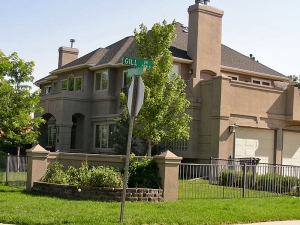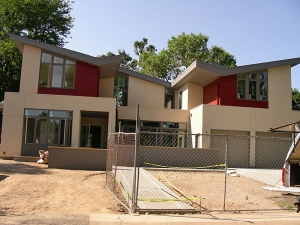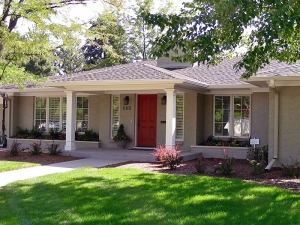 146 RESIDENCES, 142 YEARS OF HISTORY – Stokes Place / Green Bowers 1867 to 2009
146 RESIDENCES, 142 YEARS OF HISTORY – Stokes Place / Green Bowers 1867 to 2009
1867 …
Leander A. Williams purchased from the Unites States government on
January 22, 1867, 160 acres, N E 1/4, Section 13, Township 4 S, Range 68 W.
Mr. Williams paid $1.25 an acre, or a total of $200.00.
 1889 …
1889 …
Government regulations were satisfied and a patent on the land was issued to Mr. Williams, twenty-two years later, on February 21, 1889.
1889 to 1917 …
The property changed hands many times during this period. In 1917 the will of Horace Hitchings, who then owned the land, conveyed one-third of those holdings to a nephew, one-third to St. John’s Church in the Wilderness, and one-third to St. Luke’s Hospital.
 1923 …
1923 …
Berger Investment Company acquired a portion of the area as an investment in
its future.
1892 to 1933 …
Around the change of the century, much of the northern portion of the land was used for pasture. Cambridge Dairy Farm, located where Hyde Park and Central Christian complex now stand, operated since 1892 at Alameda and South Steele by the Ed T. Young, Sr. family. The Dairy sold its milk and cream from Young’s Grocery located on the southeast corner of Third Avenue and Detroit Street, in what is now called Cherry Creek North.
Much of the general area on both sides of the Creek was composed of dairies and
greenhouses. The area was affectionately known as “Cow Town”. In fact, “Bob’s”
service station carried the title of “Cow Town” across  the top of its modest
the top of its modest
building for decades. “Bob’s” was located just south of the southeast corner of
Alameda and Colorado Boulevard. The building was razed in 1994.
In 1933 when the old, brick and mortar, Castlewood Dam, near Franktown at the headwaters of Cherry Creek, collapsed, the Creek flooded from the Dam to Union Station in downtown Denver. Cambridge Dairy was inundated, and the Young family moved its cows and equipment to a 44-acre site east of Colorado Boulevard. Subsequently, Cherry Creek Dam was built by U. S. Army Engineers to preclude future flooding.
Young’s pasture lands adjacent to Stokes Place became a Mecca for gourmet mushroom gatherers. A barn near the southwest corner of the pasture was used by The  Shriners organization as a horse stable and riding arena. The stable was sold and razed with the development of Hyde Park.
Shriners organization as a horse stable and riding arena. The stable was sold and razed with the development of Hyde Park.
1937 …
As Denver began to grow southeast, the City of Denver laid water lines through what is now Stokes Place/Green Bowers. Investors saw the need for residential housing in the area, but became cautious as the rumblings of war appeared on the scene.
1945 …
Following the cessation of hostilities after World War II, manpower and building
materials slowly became available. Edward S. Stokes purchased land which would later become Stokes Place Addition. The sellers  were Berger Realty and
were Berger Realty and
Securities Company (Nov. 9, 1945), Grace A. Woodelton Smith (Nov. 10, 1945), and St. John’s Church in the Wilderness (Nov. 15,
1945).
1948 …
Edward Stokes died on May 6, 1948, before he could bring his project to fruition, and the property passed to his wife, Pauline H. Stokes.
1949 …
Mrs. Stokes conveyed her holdings to The Stokes Land Company on January 15, 1949.
1951 …
Stokes Place Addition was platted and dedicated on January 3, 1951. Denver City Council approved the Addition and its dedication on March 12, 1951.
 1952 …
1952 …
Stokes Land Company conveyed Stokes Place Addition to Mayfair Land Company. Streets and utilities were put in. Realtor George R. Morrison of Morrison and Morrison became the agent for selling building sites. Most sites sold for around $5,000.00 each. Protective covenants were adopted on September 10, 1952.
1954 …
On March 15, 1954, R-1 zoning was established for the neighborhood by City Council. Through the efforts of Herb Prouty, the neighborhood was rezoned in the next few years to R-O, the most restrictive of zoning.
Stokes Place 1953 to 1962 …
Many Stokes Place original homeowners have remained in the neighborhood for over forty years. The first house in newly-developed Stokes Place was built in
1953 at 666 (now 668) South Monroe Way by Robert and Alyce Grant. That “historical” home, after several other ownerships, is currently owned by Petey Fletcher, who acquired it in 1992 and changed the address at the time of purchase.
 The second house in Stokes Place was built in 1953 at 630 S. Monroe Way by George and Rae Helen Swerer. Mr. Swerer still resides in their home and has the distinguished honor of being one of the longest resident in the neighborhood.
The second house in Stokes Place was built in 1953 at 630 S. Monroe Way by George and Rae Helen Swerer. Mr. Swerer still resides in their home and has the distinguished honor of being one of the longest resident in the neighborhood.
Other original owners still living on South Monroe Way are Cora (Mrs. G. Rockwell) Smith (1954) and Barnie Brenimer, who, with her late husband Bob,
built on the last remaining site on Monroe Way in 1962.
One original owner on East Virginia Avenue continues to occupy her home: Cora Lee Davidson (1955).
South Garfield original owners still in Stokes Place are Bob McCurdy (1953),
Janet (Mrs. Joe) Figlino (1955) and Grace Weinel (1955).
 There are no longer any original owners on Gill Drive.
There are no longer any original owners on Gill Drive.
1955 …
Early Stokes Place residents remember the Cambridge Dairy, surrounded by a white fence, along South Colorado Boulevard where the Four Points Hotel and The
Galleria now stand. They remember that Colorado Boulevard was a gravel road
south of Exposition. They remember Green Bowers Nursery along the west side of Colorado Boulevard and Harrison Lane, extending from Exposition north to the old City Dump along Cherry Creek Drive. Some thirty years ago the dump was
reclaimed, filled and seeded for City of Brest Park.
 Green Bowers Nursery, under the expert management of Charles and Doris Wilmore, along with son “Kenny”, was the source of much of Stokes Place/Green Bowers residential landscaping. The Wilmores also were instrumental in developing Green Bowers Addition with its thirty-five building sites. The Wilmores built one of the first houses in Green Bowers at 575 South Harrison Lane and remained in the neighborhood over thirty years until their deaths.
Green Bowers Nursery, under the expert management of Charles and Doris Wilmore, along with son “Kenny”, was the source of much of Stokes Place/Green Bowers residential landscaping. The Wilmores also were instrumental in developing Green Bowers Addition with its thirty-five building sites. The Wilmores built one of the first houses in Green Bowers at 575 South Harrison Lane and remained in the neighborhood over thirty years until their deaths.
Green Bowers 1955 to 1969 …
South Harrison Street had its first occupants in 1956. Donald and Donna O’Riley built and occupied their home that year and Mrs. O’Riley still lives there. Another original owner yet in Green Bowers is Esther (Mrs. Calvin) Coyle (1957).
 Original owners currently living on Harrison Lane are Irma (Mrs. Harold) Dill
Original owners currently living on Harrison Lane are Irma (Mrs. Harold) Dill
(1957), Alan and Sally Gass (1960), Lucia (Mrs. Steve) Cowperthwaite
(1963), Marvin and Sue Lubeck (1963), Murray and Eleanor Hoffman
(1965), and Mr. And Mrs. Paul Gatchis (1995).
The neighborhood is now changing to meet the needs of today’s homeowners. Four original homes have been scraped to make way for new construction: One on South Monroe Way and three on South Garfield Street. Several homes have had major additions and renovations by their homeowners to accommodate their growing families and their desire to remain in the neighborhood.
AN ADDED NOTE OF IMPORT:
The voluntary Homeowners Association (SP/GB HOA) has been actively involved with the movement to regain the Stephen Knight School as a DPS (Denver Public  Schools) ECE (Early Childhood Education) Center. This will allow neighborhood children to ‘close to home’ and walk and/or ride their bicycles to school.
Schools) ECE (Early Childhood Education) Center. This will allow neighborhood children to ‘close to home’ and walk and/or ride their bicycles to school.
For information regarding home values and opportunities available in Stokes Place / Green Bowers call Perry & Co. Real Estate Agent Petey Fletcher, 303-777-1233
Filed under: Denver Colorado Real Estate, Denver News & Things of Interest | Leave a Comment
Tags: Denver, Denver History, Denver Neighborhoods, Green Bowers, Perry & Co, Petey Fletcher, Stokes, Stokes Place
No Responses Yet to “Hidden In The Heart Of Denver – Stokes Place / Green Bowers”